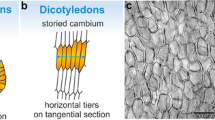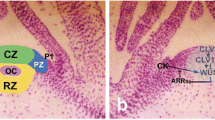Abstract
Although monocotyledons lack a vascular cambium of the type found in dicotyledons and conifers, lateral meristems still play an important role in the establishment of their growth habits. The presence near the shoot apex of a primary thickening meristem (PTM), which is probably plesiomorphic in monocotyledons, predisposes evolution into the many pachycaul forms. A PTM occurs in virtually all monocotyledons, whereas the secondary thickening meristem (STM), which is morphologically similar, is limited to a few genera of Liliiflorae. these records are reviewed in a systematic context. To a greater or lesser extent in different taxa, the PTM is responsible for primary stem thickening, adventitious root production, and formation of linkages between stem, root and leaf vasculature. The STM largely contributes to the body of the stem. The sometimes obscure distinction between the two meristems, and their relationship with other stem meristems are discussed. For systematic purposes stem thickening in monocotyledons is separated into two characters: diffuse growth (as in palms), and growth by means of lateral meristems. The three states of the second character are represented by the first three of Mangin’s (1882) four categories (two herbaceous, the third arborescent): (1) The lateral meristem is limited in extent, and ceases activity after root formation. (2) It remains active for a limited period after cessation of root formation, contributing to the plant body. (3) It remains active throughout the life of the plant, contributing the bulk of the plant body.
Resumo
Embora as monocotiledôneas não apresentem um câmbio vascular, como ocorre nas dicotiledôneas e coníferas, o meristema lateral desempenha urn papel importante na definição de seu hábito de crescimento. A presença, proximo no ápice do caule, de um meristema de espessamento primário (PTM), que, provavelmente, é plesiomórfico nas monocotiledôneas, tende a evoluir entre as muitas formas de caule contraído. O meristema de espessamento primário (PTM) ocorre virtualmente em todas as monocotiledôneas, enquanto que o meristema de espessamento secundário (STM), que é morfologicamente similar, é limitado a poucos gêneros de Liliiflorae. Estes aspectos são analisados dentro de urn contexto sistemático. Com uma maior ou menor extensão em diferentes taxa, o meristema de espessamento primário (PTM) é responsável pelo espessamento primário do caule, formação de raizes adventícias e formação de conexões entre a vascularização do caule, da raiz e das folhas. O meristema de espessamento secundário (STM) contribui grandemente para a formação do corpo caulinar. É discutida a distinção, algumas vezes obscura, entre os dois meristemas, e suas realções com os outros meristemas. Com objectivos taxonômicos, o espessamento do caule em monocotiledôneas, é separado em dois caracteres: crescimento difuso (como em Palmae) e crescimento através do meristema lateral. Os três estados deste ultimo caráter estão representados pelas três primeiras categorias (duas herbáceas e uma arborescente), entre as quatro propostas por Mangin (1882): (1) O meristema lateral é limitado em extensão e cessa a atividade após a formação da raiz. (2) Ele permanece ativo por um período limitado após a formação da raiz, contribuindo na formação do corpo da planta. (3) Permanece ativo durante toda a vida da planta, contribuindo na formação da maior parte da mesma.
Similar content being viewed by others
Literature Cited
Ball, E. 1941. The development of the shoot apex and the primary thickening meristem inPhoenix canariensis Chaub., with comparisons toWashingtonia filifera Wats., &Trachycarpus excelsa Wendl. Amer. J. Bot.28:820–832.
Boke, N. H. 1951. Histogenesis of the vegetative shoot inEchinocereus. Amer. J. Bot.38: 23–38.
Chakraverti, D. N. 1939a. The occurrence of fugacious cambium in the rhizome ofCurcuma longa L. Philippine J. Sci.69: 191–195.
—. 1939b. Secondary growth in the bulb ofPolyanthes tuberosa L. Curr. Sci.8: 263–264.
Chakroun, S. &C. Hébant. 1983. Developmental anatomy ofAphyllanthes monspeliensis, a herbaceous monocotyledon with secondary growth. Pl. Syst. Evol.141: 231–241.
Cheadle, V. I. 1937. Secondary thickening by means of a thickening ring in certain monocotyledons. Bot. Gaz.98: 535–555.
Chouard, P. 1936. La nature et la role des formations dites “secondaires” dans l’édification de la tige de monocotyledones. Bull. Soc. Bot. France83: 819–836.
Church, M. 1919. The development and structure of the bulb inCooperia drummondii. Bull. Torrey Bot. Club46: 337–362.
Coetzee, J. &H. P. Van der Schijff. 1969. Secondary thickening in geophytic Liliaceae. J. S. African Bot.35: 99–108.
Dahlgren, R. M. T., H. T. Clifford &P. F. Yeo. 1985. The families of the monocotyledons. Springer-Verlag, Berlin, Heidelberg.
DeMason, D. A. 1979a. Function and development of the primary thickening meristem in the monocotyledon,Allium cepa L. Bot. Gaz.140: 51–66.
—. 1979b. Histochemistry of the primary thickening meristem in the vegetative stem ofAllium cepa L. Amer. J. Bot.66: 347–350.
—. 1980. Localization of cell division activity in the primary thickening meristem ofAllium cepa L. Amer. J. Bot.67: 393–399.
—. 1983. The primary thickening meristem: Definition and function in monocotyledons. Amer. J. Bot.70: 955–962.
—. 1985. The continuity of primary and secondary thickening growth inCordyline terminalis (Agavaceae). Canad. J. Bot.63: 1907–1913.
Diggle, P. K. &D. A. DeMason. 1983a. The relationship between the primary thickening meristem and the secondary thickening meristem inYucca whipplei Torr. I. Histology of the mature vegetative stem. Amer. J. Bot.70: 1195–1204.
—. 1983b. The relationship between the primary thickening meristem and the secondary thickening meristem inYucca whipplei Torr. II. Ontogenetic relationship within the vegetative stem. Amer. J. Bot.70: 1205–1216.
Eckardt, T. 1941. Kritische Untersuchungen über das primäre Dickenwachstum bei Monokotylen mit Ausblick auf dessen Verhaltnis zur sekundären Verdickung. Bot. Arch.42: 289–334.
Guillard, A. 1878. Récherches sur l’anatomie comparée et le développement des tissus de la tige dans les Monocotylédones. Ann. des Sci. natur., sér. 6,5: 1–176.
Helm, J. 1936. Das Erstarkungswachstum der Palmen und einiger anderer Monokotylen überhaupt. Planta26: 319–364.
Holttum, R. E. 1955. Growth-habits in monocotyledons—Variations on a theme. Phytomorphology5: 399–413.
Hutchinson, J. 1959. The families of flowering plants. Vol. II. Monocotyledons. 2nd ed. Clarendon Press, Oxford.
Krauss, B. H. 1948. Anatomy of the vegetative organs of the pineapple,Ananas cosmosus (L.) Merr. I. Introduction, organography, the stem, and the lateral branches or axillary buds. Bot. Gaz.110: 159–217.
Lindinger, L. 1909. Die Struktur vonAloë dichotoma L., mit anschliess endenallgemeinen Betrachtungen. Beih. z. Botanischen Centrablatt. Band XXIV2: 211–253.
Lu, C-Y. &S-H. T. Chiang. 1976. Lateral thickening in the stem ofAgave rigida Mill, andAloe vera L. Taiwania21: 204–219.
Mangin, L. 1882. Origine et insertion des racines adventives et modifications corrélatives de la tîge chez les monocotylédones. Ann. Sci. Nat. Bot.14: 216–363.
Martin, B. F. &S. C. Tucker. 1985. Developmental studies inSmilax (Liliaceae). I. Organography and the shoot apex. Amer. J. Bot.72: 66–74.
Millardet, A. 1865. Sur l’anatomie et le développement du corps ligneux dans les genresYucca etDracaena. Mem. Soc. Sci. Nat. Cherbourg11: 1–24.
Paolillo, D. J. 1982. Meristems and evolution: Developmental correspondence among the rhizomorphs of the Lycopsida. Amer. J. Bot.69: 1032–1042.
Petersen, O. G. 1893. Bemaerkninger om den monokotyledone Staengels Tykkelsevaext og anatomiscke Regioner. Bot. Tidsskr.18: 112–124.
Puri, Y. P., C. R. Stanton, S. Assavena & D. W. Fisher. 1966. Anatomical and agronomic studies ofPhormium in Western Oregon. U.S. Dept. Agric., Agric. Res. Service. Production Res. Rep. no. 93.
Reyneke, W. F. &H. P. Van der Schijff. 1972. Primary thickening in the stem ofEucomis pallidiflora Baker. Ber. Deutsch. Bot. Ges.85: 631–641.
Rohweder, O. 1963. Anatomische und histogenetische Untersuchungen an Laubsprossen und Bluten der Commelinaceen. Bot. Jahrb.82: 1–99.
Röseler, P. 1889. Das Dickenwachstum und die Entwicklungsgeschichte der secundären Gefässbündel dei den baumartigen Lilien. Jahrb. Wiss. Bot.20: 292–348.
Rudall, P. 1984. Taxonomic and evolutionary implications of rhizome structure and secondary thickening in Iridaceae. Bot. Gaz.145: 524–534.
—. 1989. Stem thickening growth in bulbous Iridaceae. Bot. Gaz.150: 132–138.
Schoute, J. C. 1903. Die Stammesbildung der Monokotylen. Flora92: 32–48.
Scott, D. H. &G. Brebner. 1893. On the secondary tissues in certain monocotyledons. Ann. Bot.7: 22–62.
Sharma, O. P. 1975. Initiation of the primary thickening meristem inDioscorea glabra Roxb. Curr. Sci.44: 626–627.
Skutch, A. F. 1932. Anatomy of the axis of banana. Bot. Gaz.93: 233–258.
Staff, I. A. & J. T. Waterhouse. 1981. The biology of arborescent monocotyledons, with special reference to Australian species. Pages 216–257in J. S. Pate & A. J. McComb (eds.), The biology of Australian plants. Nedlands (WA).
Stevenson, D. W. 1976. Shoot apex organization and origin of the rhizome-borne roots and their associated gaps inDennstaedtia cicutaria. Amer. J. Bot.63: 673–678.
—. 1978. Observations on shoot apices of eusporangiate ferns. Kew Bull.33: 279–282.
—. 1980a. Radial growth inBeaucarnea recurvata. Amer. J. Bot.67: 476–489.
—. 1980b. Radial growth in the Cycadales. Amer. J. Bot.67: 465–475.
—. 1990. Morphology and systematics of the Cycadales. Mem. N.Y. Bot. Gard.57: 8–55.
—. 1980. The developmental relationship between primary and secondary thickening growth inCordyline (Agavaceae). Bot. Gaz.141: 264–268.
—. 1973. Ontogeny of the primary thickening meristem in seedlings ofBougainvillea spectabilis. Amer. J. Bot.60: 1–9.
Tomlinson, P. B. &M. H. Zimmermann. 1969. Vascular anatomy of monocotyledons with secondary growth—An introduction. J. Arnold Arbor.50: 159–179.
Versluys, M. 1925. The mode of growing of foliage-leaves, sheath-leaves and bulb-disc inHyacinthus orientalis. Rec. Trav. bot. Néer.22: 1–108.
Waterhouse, J. T. 1987. The phylogenetic significance ofDracaena-type growth. Proc. Linn. Soc. N.S.W.109: 129–138.
Wetter, R. &C. Wetter. 1954. Studien über das Erstarkungswachstum und das primäre Dickenwachstum bei leptosporangiaten Farnen. Flora141: 598–631.
Zimmermann, M. H. &P. B. Tomlinson. 1967. Anatomy of the palmRhapis excelsa, IV. Vascular development in apex of vegetative aerial axis and rhizome. J. Arnold Arbor.48: 122–142.
—. 1968. Vascular construction and development in the aerial stem ofPrionium (Juncaceae). Amer. J. Bot.55: 1100–1109.
—. 1969. The vascular system in the axis ofDracaena fragrans (Agavaceae). 1. Distribution and development of primary strands. J. Arnold Arbor.50: 370–383.
—. 1970. The vascular system in the axis ofDracaena fragrans (Agavaceae) 2. Distribution and development of secondary vascular tissue. J. Arnold Arbor.51: 478–491.
—. 1972. The vascular anatomy of monocotyledonous stems. Bot. Gaz.133: 141–155.
—. 1974. Vascular patterns in palm stems: Variations of theRhapis principle. J. Arnold Arbor.55: 402–424.
Author information
Authors and Affiliations
Rights and permissions
About this article
Cite this article
Rudall, P. Lateral meristems and stem thickening growth in monocotyledons. Bot. Rev 57, 150–163 (1991). https://doi.org/10.1007/BF02858768
Issue Date:
DOI: https://doi.org/10.1007/BF02858768




